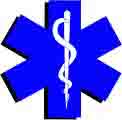 On June 2 Wildfire Today covered the release of some new protocols developed by the National Wildfire Coordinating Group about managing medical emergencies on incidents. Redding, California’s Record Searchlight, which frequently covers wildfire issues, has an article published yesterday about the new policy, including quotes from several recognizable names in the wildland fire community. Read the article — but here is an excerpt:
On June 2 Wildfire Today covered the release of some new protocols developed by the National Wildfire Coordinating Group about managing medical emergencies on incidents. Redding, California’s Record Searchlight, which frequently covers wildfire issues, has an article published yesterday about the new policy, including quotes from several recognizable names in the wildland fire community. Read the article — but here is an excerpt:
“They are really going to set up plans to get firefighters out within an hour,” said Jim Milestone, superintendent of the Whiskeytown National Recreation Area. “The idea is to get that person out of there.”
Like generals planning for battle, managers of major forest fires meet early each morning to devise the day’s strategies.
As part of the planning in the past they’ve outlined basic plans for treating fire-line injuries, discussing only generally how fire crews will respond to a severe injury on the fire line, Milestone said.
This fire season the plans will be more detailed and focused on how to retrieve injured firefighters as quickly as possible.
On the Shasta-Trinity National Forest this year there will be an emphasis on continually creating fire plans that include “solid and effective” medical evacuation plans, said Jim Peña, the U.S. Forest Service’s deputy regional forester for California.
“The idea is to assess where we work in the forest,” he said. “This isn’t just focused on fire.”
The goal is to avoid another death like that of Andrew “Andy” Palmer.
Palmer, 18, of Port Townsend, Wash., died after an 8-foot section of pine tree fell on him while he fought a fire near Junction City in 2008. Palmer’s family and fire officials who reviewed a federal investigation of his death say it could have been prevented by a quicker medical response. The tree broke Palmer’s left leg and severed his femoral artery, but Palmer lay on the ground for more than 2½ hours as firefighters tried to figure out how to get him to a hospital.
A better rescue plan could have saved Palmer’s life, said Milestone, who was a member of the federal team that investigated the death.
I wish what Superintendent Milestone said were true:
They are really going to set up plans to get firefighters out within an hour.
Unfortunately, the new NWCG protocols fell short of establishing target time frames for getting a seriously injured patient to an appropriate medical facility. During the development of the strategy and tactics for a fire, the feasibility of timely medevac must be considered. If, for example, the location of a remote work assignment during a night shift would require 30 minutes of on-scene treatment, then a 90-minute carry-out followed by a one-hour ground ambulance ride, then the Medical Unit Leader, the Safety Officer, the Operations Section Chief, and the Incident Commander need to discuss ways to mitigate that problem.
While the new NWCG protocols are a step in the right direction, they should have also recommended transport time frames and the number of EMTs to be assigned to an incident.

emt need to be assignined to each crew or 4 to a module or mobile emt station within division where crews are operating no more emt,s at the bottom of the hill!